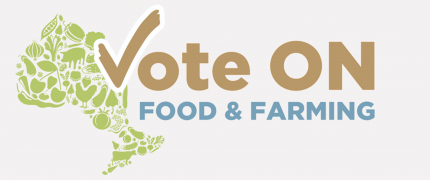Vote ON Food 2025 Election!
Posted: February 5, 2025
Categories: GoodFoodBites / News from Sustain Ontario
VOTE ON 2025 is now live!
Please share far and wide.
Priorities brought together from over 90+ organizations are listed here, with fuller details coming out soon.
MPP Candidate responses will be hosted on the Vote ON page as well. Collaborate to share the survey with candidates in your community.
Together, let’s make Good Food for All a Priority for the 2025 ON Election.
(Certains documents sont disponibles en français. Veuillez noter que même si Sustain a engagé un traducteur professionnel, nous n’avons pas pu remplacer le plug-in anglais-français du site Web actuel, et la traduction générée par ordinateur sur certains éléments est donc désormais disponsible. Nos propres documents traduits seront disponibles jusqu’à vendredi en fin de journée, date à laquelle ce problème sera résolu. Merci!)

